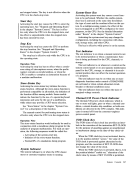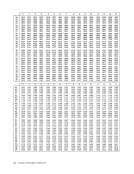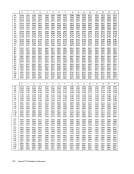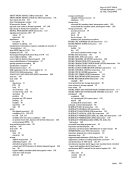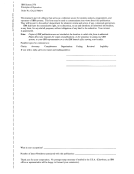status portion, and the subchannel is immediately
made available to the program. TheI/O operation,
however, is initiated, and, if channel end is not ac
companied by device end, the device remains busy.
Device end, when subsequently provided by the
device, causes an interruption condition to be gener
ated.
An immediate operation initiated by the first
CCW designated by the CAW during a STARTI/O FAST RELEASE executed independently of the
addressed device appears to the program as a non
immediate command. That is, any status generated
by the device for the immediate command, or for a
subsequent command if command chaining occurs,
causes an interruption condition to be generated.
When command chaining is specified after an
immediate operation and no unusual conditions have
been detected during the execution, or when com
mand retry occurs for an immediate operation, nei
ther STARTI/O nor START I/O FAST RELEASE
causes the immediate storing of CSW status. The
subsequent commands in the chain are handled nor
mally, and the channel-end condition for the last
operation generates an interruption condition even if
the device provides the signal immediately upon
receipt of the command code.
Whenever immediate completion of anI/O opera
tion is signaled, no data has been transferred to or
from the device. The data address in the CCW is not
checked for validity.
Since a count of zero is not valid, any CCW spec
ifying an immediate operation must contain a nonze
ro count. When an immediate operation is executed,
however, incorrect length is not indicated to the
program, and command chaining is performed when
so specified.
Programming Note
Control operations for which the entire operation is
specified in the command code may be executed as
immediate operations. Whether the control function
is executed as an immediate operation depends on
the operation and type of device and is specified in
the SL or SRL publication for the device.
Conclusion of Data Transfer
When the device accepts a command, the subchannel
is set up for data transfer. The subchannel is said to
be working during this period. Unless the channel
detects equipment malfunctioning or the operation is
concluded by CLEAR 1/0, or, on the selector chan
nel, the operation is concluded by CLEAR I/O,
HALT I/O, or HALT DEVICE, the working state
lasts until the channel receives the channel-end sig
nal from the device. When no command chaining is
specified or when chaining is suppressed because of
unusual conditions, the channel-end condition causes
the operation at the subchannel to be terminated and
an interruption condition to be generated. The status
bits in the associated CSW indicate channel end and
the unusual conditions, if any. The device can signal
channel end at any time after initiation of the opera
tion, and the signal may occur before any data has
been transferred.
For operations not involving data transfer, the
device normally controls the timing of the channel
end condition. The duration of data transfer opera
tions may be variable and may be controlled by the
device or the channel.
Excluding equipment errors, CLEAR I/O, HALT
DEVICE, and HALT I/O, the channel signals the
device to conclude data transfer whenever any of the
following conditions occurs:
The storage areas specified for the operation are
exhausted or filled.
Program-check condition is detected.
Protection-check condition is detected.
Chaining-check condition is detected.
The first of these conditions occurs when the
channel has stepped the count to zero in the last
CCW associated with the operation. A count of zero
indicates that the channel has transferred all infor
mation specified by the program. The other three con
ditions are due to errors and cause premature con
cluding of data transfer. In either case, the conclud
ing is signaled in response to a service request from
the device and causes data transfer to cease. If the
device has no blocks defined for the operation (such
as writing on magnetic tape), it concludes the opera
tion and generates the channel-end condition.
The device can control the duration of an opera
tion and the timing of channel end by blocking of
data.On certain operations for which blocks are
defined (such as reading on magnetic tape), the de
vice does not provide the channel-end signal until
the end of the block is reached, regardless of wheth
er or not the device has been previously signaled to
conclude data transfer.
Checking for the validity of the data address is
performed only as data is transferred to or from
main storage. When the initial data address in the
CCW is invalid, no data is transferred during the
operation, and the device is signaled to conclude the
operation in response to the first service request.On writing, devices such as magnetic tape units request
the first byte of data before any mechanical motion
is started and, if the initial data address is invalid, the
operation is concluded before the recording medium
has been advanced. However, since the operation
has been initiated, the device provides channel end,
Input/Output Operations 223
made available to the program. The
however, is initiated, and, if channel end is not ac
companied by device end, the device remains busy.
Device end, when subsequently provided by the
device, causes an interruption condition to be gener
ated.
An immediate operation initiated by the first
CCW designated by the CAW during a START
addressed device appears to the program as a non
immediate command. That is, any status generated
by the device for the immediate command, or for a
subsequent command if command chaining occurs,
causes an interruption condition to be generated.
When command chaining is specified after an
immediate operation and no unusual conditions have
been detected during the execution, or when com
mand retry occurs for an immediate operation, nei
ther START
causes the immediate storing of CSW status. The
subsequent commands in the chain are handled nor
mally, and the channel-end condition for the last
operation generates an interruption condition even if
the device provides the signal immediately upon
receipt of the command code.
Whenever immediate completion of an
tion is signaled, no data has been transferred to or
from the device. The data address in the CCW is not
checked for validity.
Since a count of zero is not valid, any CCW spec
ifying an immediate operation must contain a nonze
ro count. When an immediate operation is executed,
however, incorrect length is not indicated to the
program, and command chaining is performed when
so specified.
Programming Note
Control operations for which the entire operation is
specified in the command code may be executed as
immediate operations. Whether the control function
is executed as an immediate operation depends on
the operation and type of device and is specified in
the SL or SRL publication for the device.
Conclusion of Data Transfer
When the device accepts a command, the subchannel
is set up for data transfer. The subchannel is said to
be working during this period. Unless the channel
detects equipment malfunctioning or the operation is
concluded by CLEAR 1/0, or, on the selector chan
nel, the operation is concluded by CLEAR I/O,
HALT I/O, or HALT DEVICE, the working state
lasts until the channel receives the channel-end sig
nal from the device. When no command chaining is
specified or when chaining is suppressed because of
unusual conditions, the channel-end condition causes
the operation at the subchannel to be terminated and
an interruption condition to be generated. The status
bits in the associated CSW indicate channel end and
the unusual conditions, if any. The device can signal
channel end at any time after initiation of the opera
tion, and the signal may occur before any data has
been transferred.
For operations not involving data transfer, the
device normally controls the timing of the channel
end condition. The duration of data transfer opera
tions may be variable and may be controlled by the
device or the channel.
Excluding equipment errors, CLEAR I/O, HALT
DEVICE, and HALT I/O, the channel signals the
device to conclude data transfer whenever any of the
following conditions occurs:
The storage areas specified for the operation are
exhausted or filled.
Program-check condition is detected.
Protection-check condition is detected.
Chaining-check condition is detected.
The first of these conditions occurs when the
channel has stepped the count to zero in the last
CCW associated with the operation. A count of zero
indicates that the channel has transferred all infor
mation specified by the program. The other three con
ditions are due to errors and cause premature con
cluding of data transfer. In either case, the conclud
ing is signaled in response to a service request from
the device and causes data transfer to cease. If the
device has no blocks defined for the operation (such
as writing on magnetic tape), it concludes the opera
tion and generates the channel-end condition.
The device can control the duration of an opera
tion and the timing of channel end by blocking of
data.
defined (such as reading on magnetic tape), the de
vice does not provide the channel-end signal until
the end of the block is reached, regardless of wheth
er or not the device has been previously signaled to
conclude data transfer.
Checking for the validity of the data address is
performed only as data is transferred to or from
main storage. When the initial data address in the
CCW is invalid, no data is transferred during the
operation, and the device is signaled to conclude the
operation in response to the first service request.
the first byte of data before any mechanical motion
is started and, if the initial data address is invalid, the
operation is concluded before the recording medium
has been advanced. However, since the operation
has been initiated, the device provides channel end,
Input/Output Operations 223
























































































































































































































































